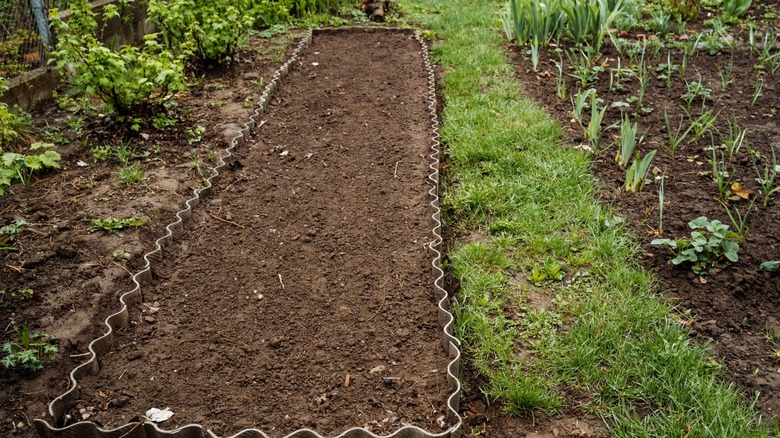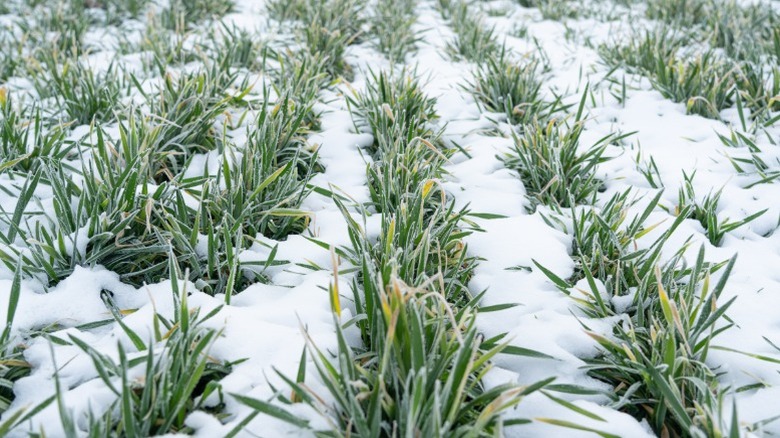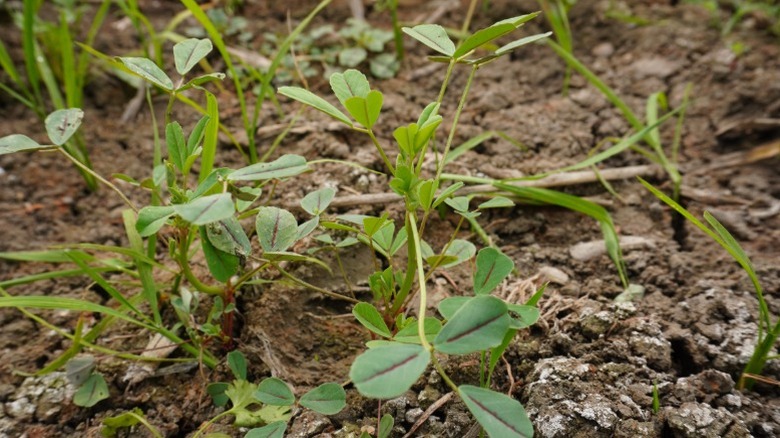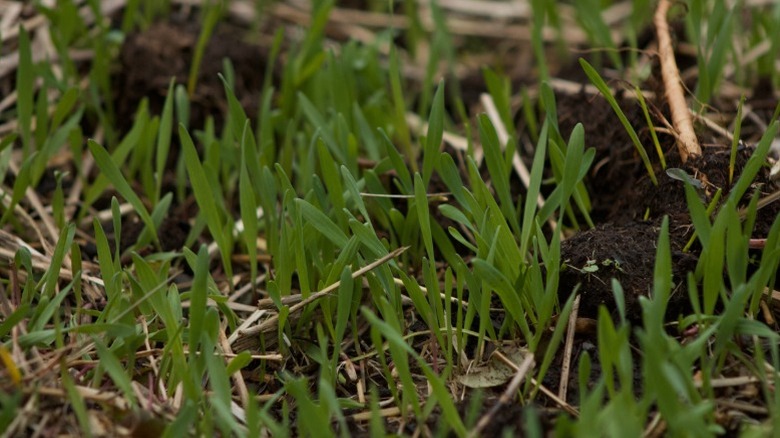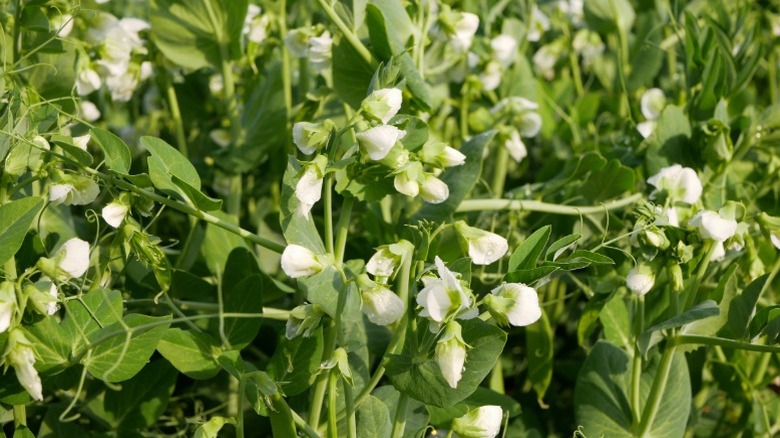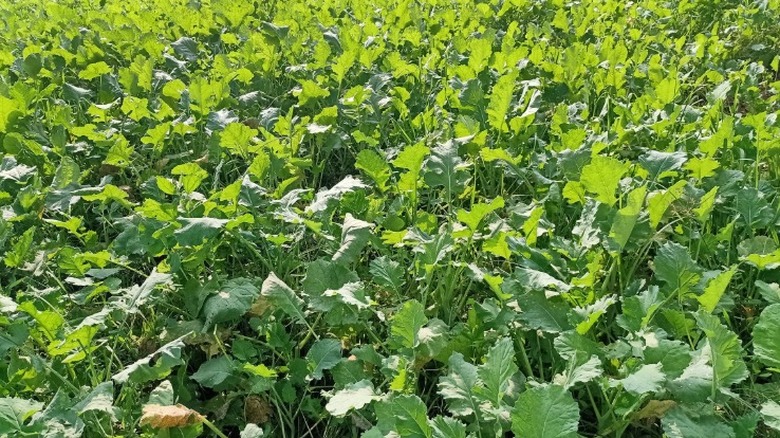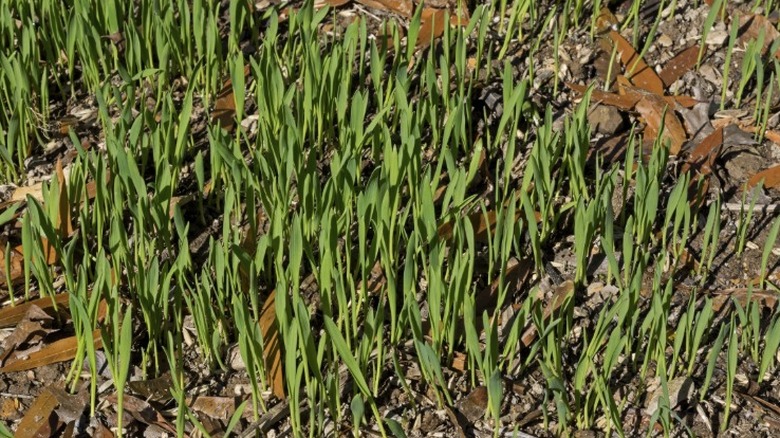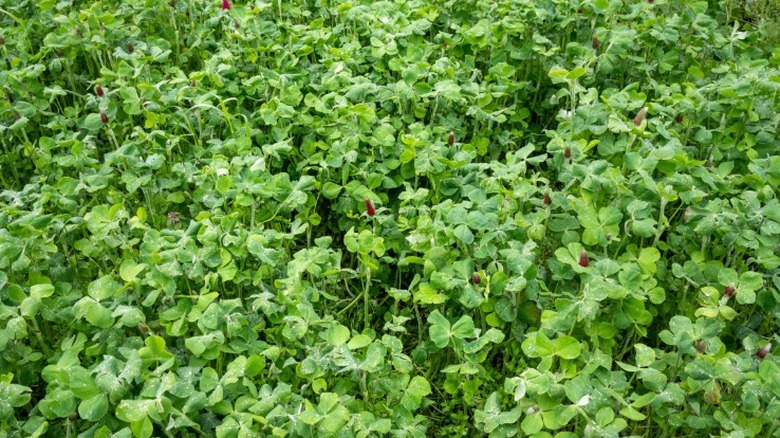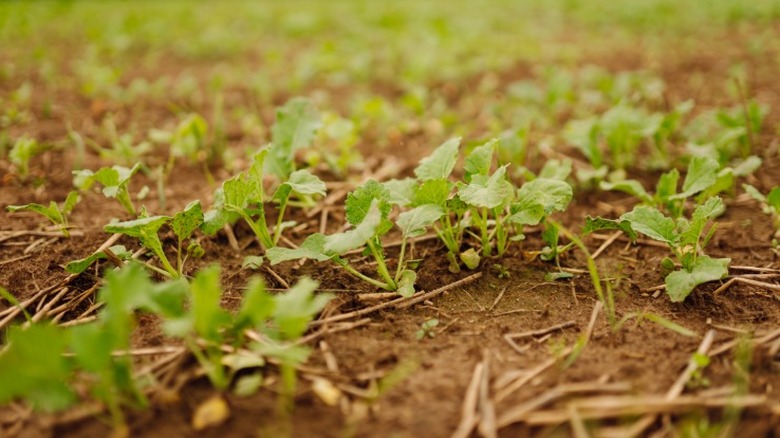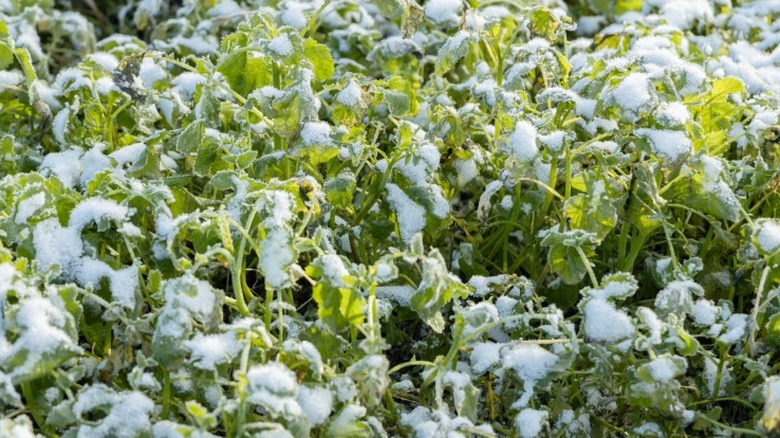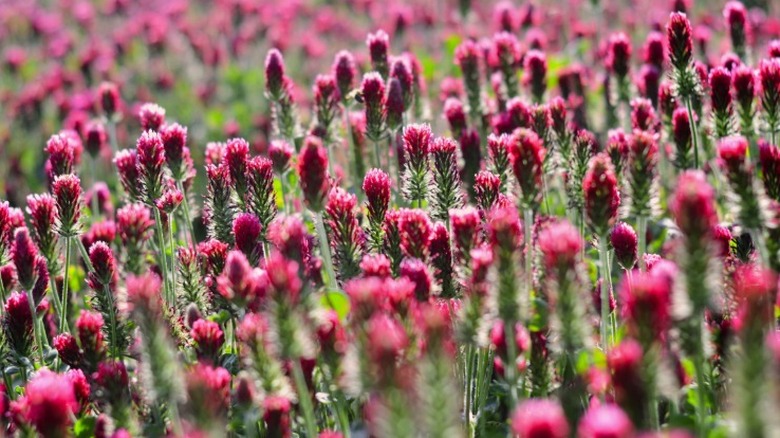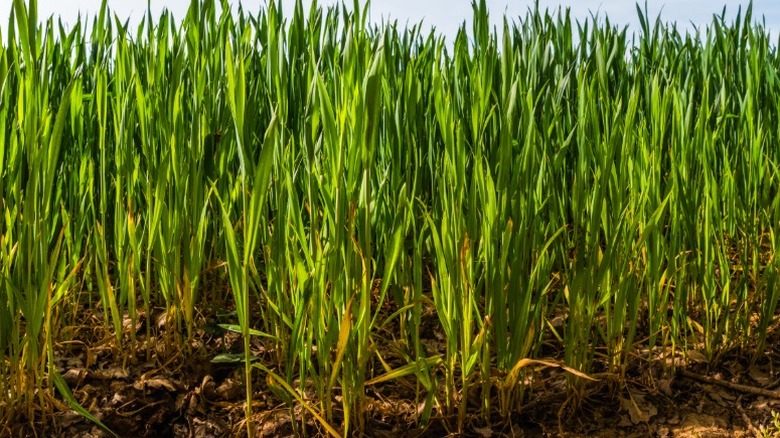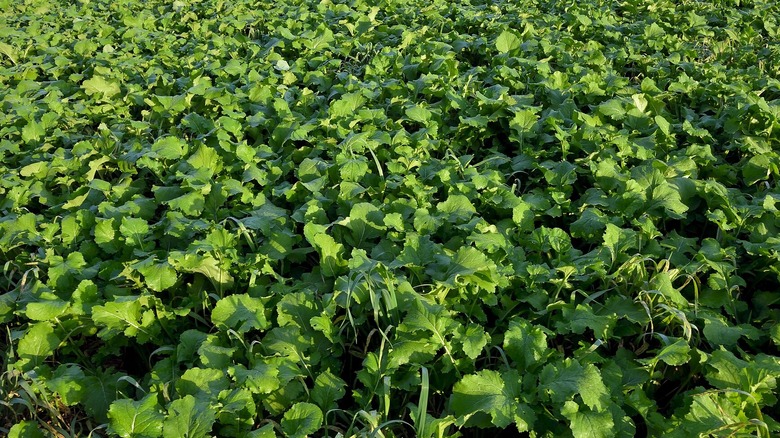12 Cover Crops To Plant In The Fall For Healthy Garden Soil In The Spring
In the fall, you might be tempted to remove the dead plant material, till your garden soil a bit, and put your garden to bed for the winter without another thought. However, you can also grow cover crops to create healthier soil in your garden for spring. By planting cover crops in the fall instead of leaving your garden plots empty, you can restore vital nutrients to the soil and prevent too much erosion into your surrounding yard. Another added benefit is that a cover crop can suppress the growth of pesky weeds in an empty garden.
Whether you choose a cereal grain, such as winter wheat, or a legume, such as winter peas, planting cover crops builds better soil in a garden that would otherwise be empty. Although they're called cover crops, the goal is not to harvest them. The cover crop often gets tilled into the garden in the spring, adding organic matter to grow strong, healthy vegetables.
Aim to get a cover crop planted between late August and early October. While planning which cover crop to grow, consider your USDA Hardiness Zone and whether you want a species that will die or survive over the winter. A crop that dies during the winter is ideal if you plan to start gardening again in early spring. Opt for an overwintering cover crop if you need to wait to clear the garden of your late harvest plants, like tomatoes. These crops can be started later in the fall.
Winter wheat may be more cost effective
If you need a manageable non-legume cover crop, winter wheat (Triticum aestivum) fits the bill. Winter wheat is also one of the best types of cover crops for a raised garden bed thanks to its ability to suppress weeds. Depending on your location, it can be planted mid to late October with good results. Ensure a soil temperature of at least 38 degrees Fahrenheit for proper seed germination. You can wait until two or three weeks before planting in spring, using a method like tilling to properly kill it so it doesn't become weedy.
Grow berseem clover which breaks down in spring
A type of legume that is best sown in early fall, berseem clover (Trifolium alexandrinum) grows quickly and is often recommended for home garden use. Plant this cover crop in fall to help fix nitrogen and prevent weeds for renewed soil by the time spring rolls around. An annual type of clover, berseem clover is different from other species of clover that will not die off over the winter. Note that berseem clover requires a minimum 42 degrees Fahrenheit soil for germination.
Get winter rye in the ground later in fall
Unlike some fall cover crops, winter rye (Secale cereale L.), or cereal rye, you don't have to rush to get planted in the fall. It's also the hardiest cereal grain option, germinating in cool soil, needing a minimum of only 34 degrees Fahrenheit. Note that winter rye has a high carbon to nitrogen ratio. Allow for time in spring to let it break down completely after it's been killed, or mix it with a legume cover crop. Before seeds set, cut down the rye to use as mulch for a healthy spring vegetable garden.
Plant peas for nitrogen fixation
Another type of legume popularly used as a cover crop to fix nitrogen in the soil, peas (Pisum sativum) typically do not survive the winter and break down into organic material in the spring. Along with being an affordable way to add nitrogen to your soil for a healthier garden, peas exhibit a decent spread of 2 to 4 feet. Yellow field peas, speckled field peas, and Austrian winter peas are all common varieties used as cover crops, although with varying winter hardiness. Requires minimum soil temperature of 41 degrees Fahrenheit.
Break up compacted soil with oilseed radish
Legumes and cereal grains are not the only cover crops useful for improving soil by spring. Oilseed, or tillage radish (Raphanus sativus), a type of forage radish, is a brassica cover crop with a rapid growth rate. Plant in your garden in early fall, as they are not very cold hardy and will die in early winter. These radishes grow a very large taproot that loosens soil that's become compacted over time, plus radish seed is affordable. Avoid tillage radish as a cover if you plan to grow brassicas in spring, including broccoli or cabbage.
Oats are not just for the horses
Affordability can be a major selling point for a cover crop, especially if you have a big garden plot, and oats (Avena sativa) are pretty inexpensive. This type of cereal grain needs to be planted sooner in fall compared to hardier cereals like winter wheat and rye. However, it's notable for its fibrous root system that acts as a soil builder. Additionally, an oat cover crop prevents excessive erosion for richer soil in the spring. Although it is used to scavenge nitrogen, pair it with legumes like peas or berseem clover to get more nitrogen.
Use red clover to break up soil and attract pollinators
Red clover (Trifolium pratense) is one example of a cover crop that will help suppress weeds in your garden without needing a lot of water. Red clover is a legume cover crop that typically overwinters, which allows for later planting in the fall. In addition to its weed fighting ability, this cover crop is very good at preventing compaction in garden soil. Seeds require soil temperatures of 41 degrees Fahrenheit for germination. In the spring, till it into soil before flowering to kill the clover and give your veggies rich organic matter.
Plant rapeseed later in fall to improve soil health
Consider a brassica cover crop like rapeseed (Brassica napus) which grows a strong taproot to fight erosion and traps excess nitrogen in the soil for healthier spring soil. This cover crop needs minimum soil temperatures of 41 degrees Fahrenheit for germination. Plan to sow seeds by mid to late October to allow for time to establish roots. Overwintering depends on the variety of rapeseed, with 'Rangi' being the least hardy and 'Bonar' being the most. As this cover crop grows, it starts off as a rosette before bolting and developing small, yellow flowers.
Suppress weeds and disease with mustard greens
Mustard greens (Brassica juncea) is a species of brassica that you can grow as a cover crop in the fall, from August to October, to prepare for a spring garden. Minimum germination temperature for the soil is 40 degrees Fahrenheit, allowing for later planting of this cover crop. Mustard is unique, because it produces natural herbicide to suppress weeds. Another benefit to the soil is its ability to reduce harmful, soil borne diseases and even suppress nematodes. Be careful about mustard's weedy tendencies and never let it go to seed.
Fix nitrogen with crimson clover instead of hairy vetch
Crimson clover (Trifolium incarnatum) is similar to hairy vetch (Vicia villosa) when it comes to nitrogen fixation and soil building, but without the issues found with hairy vetch. This clover is a distinct species from red clover, as it is an annual with a faster growth rate. Grow this cool-season legume to capitalize on its ability to reduce compaction and create better soil before its time to plant in spring. Start seeds in early fall where it will do well in cooler temperatures and help keep weeds out of garden beds.
Plant drought-tolerant barley for cover
Although barley (Hordeum vulgare) is not as hardy as rye, this cool-season grass serves as a reliable cover crop for the home gardener. Barley can prevent erosion, suppress weeds, and more to promote healthier soil in the springtime. A hardy cover crop, barley seed can germinate in soil temperatures as low as 35 to 38 degrees Fahrenheit. Get it in the ground by mid-October where it usually overwinters until spring, barring heavy snowfall in the winter. Ensure you properly till or mow this crop down in spring before planting again in your beds.
Forage turnip can help with water infiltration
Depending on where you live, forage turnips (Brassica rapa) could be a good option for a ground cover that you can plan to plant from early to mid fall. Using them as a cover crop means you can improve soil health by reducing compaction and maintaining nitrogen.Try to germinate this brassica ground cover before soil temperatures reach below 45 degrees Fahrenheit. A mild winter may mean that forage turnips survive until spring. However, turnips grown as cover crops also often die off when temperatures reach under 25 degrees Fahrenheit.
